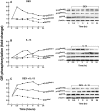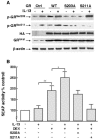Pro-asthmatic cytokines regulate unliganded and ligand-dependent glucocorticoid receptor signaling in airway smooth muscle
- PMID: 23593222
- PMCID: PMC3617099
- DOI: 10.1371/journal.pone.0060452
Pro-asthmatic cytokines regulate unliganded and ligand-dependent glucocorticoid receptor signaling in airway smooth muscle
Abstract
To elucidate the regulation of glucocorticoid receptor (GR) signaling under pro-asthmatic conditions, cultured human airway smooth muscle (HASM) cells were treated with proinflammatory cytokines or GR ligands alone and in combination, and then examined for induced changes in ligand-dependent and -independent GR activation and downstream signaling events. Ligand stimulation with either cortisone or dexamethsone (DEX) acutely elicited GR translocation to the nucleus and, comparably, ligand-independent stimulation either with the Th2 cytokine, IL-13, or the pleiotropic cytokine combination, IL-1β/TNFα, also acutely evoked GR translocation. The latter response was potentiated by combined exposure of cells to GR ligand and cytokine. Similarly, treatment with either DEX or IL-13 alone induced GR phosphorylation at its serine-211 residue (GR(Ser211)), denoting its activated state, and combined treatment with DEX+IL-13 elicited heightened and sustained GR(Ser211) phosphorylation. Interestingly, the above ligand-independent GR responses to IL-13 alone were not associated with downstream GR binding to its consensus DNA sequence or GR transactivation, whereas both DEX-induced GR:DNA binding and transcriptional activity were significantly heightened in the presence of IL-13, coupled to increased recruitment of the transcriptional co-factor, MED14. The stimulated GR signaling responses to DEX were prevented in IL-13-exposed cells wherein GR(Ser211) phosphorylation was suppressed either by transfection with specific serine phosphorylation-deficient mutant GRs or treatment with inhibitors of the MAPKs, ERK1/2 and JNK. Collectively, these novel data highlight a heretofore-unidentified homeostatic mechanism in HASM cells that involves pro-asthmatic cytokine-driven, MAPK-mediated, non-ligand-dependent GR activation that confers heightened glucocorticoid ligand-stimulated GR signaling. These findings raise the consideration that perturbations in this homeostatic cytokine-driven GR signaling mechanism may be responsible, at least in part, for the insensirtivity to glucocorticoid therapy that is commonly seen in individuals with severe asthma.
Conflict of interest statement
Figures








Similar articles
-
Th2 cytokine-induced upregulation of 11beta-hydroxysteroid dehydrogenase-1 facilitates glucocorticoid suppression of proasthmatic airway smooth muscle function.Am J Physiol Lung Cell Mol Physiol. 2009 May;296(5):L790-803. doi: 10.1152/ajplung.90572.2008. Epub 2009 Feb 27. Am J Physiol Lung Cell Mol Physiol. 2009. PMID: 19251840 Free PMC article.
-
Glucocorticoid and TNF signaling converge at A20 (TNFAIP3) to repress airway smooth muscle cytokine expression.Am J Physiol Lung Cell Mol Physiol. 2016 Aug 1;311(2):L421-32. doi: 10.1152/ajplung.00179.2016. Epub 2016 Jul 1. Am J Physiol Lung Cell Mol Physiol. 2016. PMID: 27371733 Free PMC article.
-
Basal p38 mitogen-activated protein kinase regulates unliganded glucocorticoid receptor function in airway smooth muscle cells.Am J Respir Cell Mol Biol. 2014 Feb;50(2):301-15. doi: 10.1165/rcmb.2012-0522OC. Am J Respir Cell Mol Biol. 2014. PMID: 24024586 Free PMC article.
-
Cytokine regulation of beta-adrenergic responses in airway smooth muscle.J Allergy Clin Immunol. 2002 Dec;110(6 Suppl):S255-60. doi: 10.1067/mai.2002.129947. J Allergy Clin Immunol. 2002. PMID: 12464933 Review.
-
How glucocorticoid receptors modulate the activity of other transcription factors: a scope beyond tethering.Mol Cell Endocrinol. 2013 Nov 5;380(1-2):41-54. doi: 10.1016/j.mce.2012.12.014. Epub 2012 Dec 23. Mol Cell Endocrinol. 2013. PMID: 23267834 Review.
Cited by
-
Context-dependent cooperation between nuclear factor κB (NF-κB) and the glucocorticoid receptor at a TNFAIP3 intronic enhancer: a mechanism to maintain negative feedback control of inflammation.J Biol Chem. 2014 Mar 21;289(12):8231-9. doi: 10.1074/jbc.M113.545178. Epub 2014 Feb 5. J Biol Chem. 2014. PMID: 24500711 Free PMC article.
-
Interleukin-1β regulates the expression of glucocorticoid receptor isoforms in nasal polyps in vitro via p38 MAPK and JNK signal transduction pathways.J Inflamm (Lond). 2015 Jan 20;12(1):3. doi: 10.1186/s12950-014-0046-z. eCollection 2015. J Inflamm (Lond). 2015. PMID: 25632272 Free PMC article.
-
Ectopic microRNA-150-5p transcription sensitizes glucocorticoid therapy response in MM1S multiple myeloma cells but fails to overcome hormone therapy resistance in MM1R cells.PLoS One. 2014 Dec 4;9(12):e113842. doi: 10.1371/journal.pone.0113842. eCollection 2014. PLoS One. 2014. PMID: 25474406 Free PMC article.
-
Decoding the temporal nature of brain GR activity in the NFκB signal transition leading to depressive-like behavior.Mol Psychiatry. 2021 Sep;26(9):5087-5096. doi: 10.1038/s41380-021-01016-1. Epub 2021 Jan 22. Mol Psychiatry. 2021. PMID: 33483691 Free PMC article.
-
Lipid raft- and protein kinase C-mediated synergism between glucocorticoid- and gonadotropin-releasing hormone signaling results in decreased cell proliferation.J Biol Chem. 2014 Apr 4;289(14):10235-51. doi: 10.1074/jbc.M113.544742. Epub 2014 Feb 19. J Biol Chem. 2014. PMID: 24558046 Free PMC article.
References
-
- Barnes PJ (1998) Anti-inflammatory actions of glucocorticoids: molecular mechanisms. Clin Sci 94: 557–572. - PubMed
-
- Webster JC, Cidlowski JA (1999) Mechanisms of glucocorticoid-receptor-mediated repression of gene expression. Trends Endocrinol Metab 10: 396–402. - PubMed
-
- Kino T, De Martino MU, Charmandari E, Mirani M, Chrousos GP (2003) Tissue glucocorticoid resistance/hypersensitivity syndromes. J Steroid Biochem Mol Biol 85: 457–467. - PubMed
-
- Chapman KE, Coutinho A, Gray M, Gilmour JS, Savill JS, et al. (2006) Local Amplification of Glucocorticoids by 11β-Hydroxysteroid Dehydrogenase Type 1 and Its Role in the Inflammatory Response. Ann NY Acad Sci 1088: 265–273. - PubMed
-
- Cooper MS, Bujalska I, Rabbitt E, Walker EA, Bland R, et al. (2001) Modulation of 11beta-hydroxysteroid dehydrogenase isozymes by proinflammatory cytokines in osteoblasts: an autocrine switch from glucocorticoid inactivation to activation. J Bone Miner Res 16: 1037–1044. - PubMed
Publication types
MeSH terms
Substances
Grants and funding
LinkOut - more resources
Full Text Sources
Other Literature Sources
Molecular Biology Databases
Research Materials
Miscellaneous

